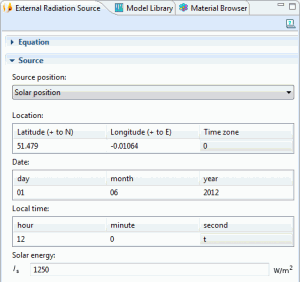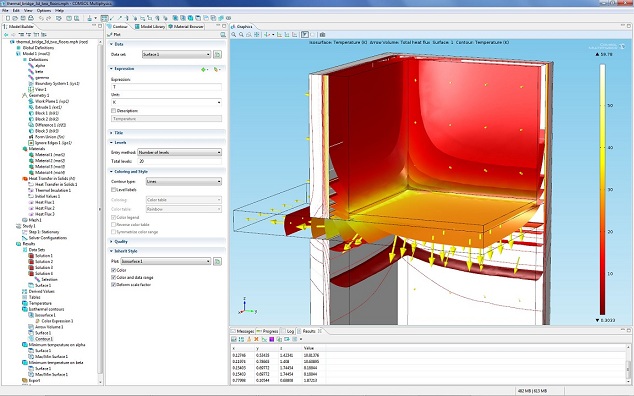
Knowing the sun’s radiation and thermal effects is very important to designers within the building industry, especially in designing “green” buildings. Heat transfer also plays a vital role in designing outdoor devices in terms of maintaining temperatures in extreme hot or cold environments. To use the words of Nicolas Huc, project leader for the Heat Transfer Module development at COMSOL in France: “it makes a huge difference if you forget to take the sun’s radiation into account.”
Analyzing Solar Radiation
As of version 4.3 of the COMSOL Multiphysics® software and add-on Heat Transfer Module, external radiation sources can be defined in 3D for all physics user interfaces via the Solar Position option. You can easily define the direction and intensity of the sun’s incident radiation based on the latitude and longitude position on Earth, the date, and the time with this new option. (The solar position is only based on the position on Earth, not any other planet or the moon, but it is fine for airplanes and might work for a satellite orbiting close to Earth).

Defining an external radiation source using the Solar Position option.
The refractive index parameter has also been implemented to enable modeling of radiation through glass, water, and other media with a refractive index different than 1.0. Additionally, radiative heat transfer between thin structures is now possible when surface-to-surface radiation is used together with the Thin Conductive Shell user interface. This is great news for those involved in heat transfer projects.
So long, dense meshes! Thin walls can now be represented as interior boundaries instead of having to define a solid domain with a wall boundary condition on both sides. A wall condition can be defined between two fluid domains with the Interior Wall boundary condition, which is available in the Conjugate Heat Transfer and Nonisothermal Flow interfaces. To read about more updates to the Heat Transfer Module, check out the 4.3 Release Highlights page.
Example: Analyzing Thermal Bridges with Heat Transfer Simulation
As an example, take a look at the following model, which represents part of a building, displaying its walls, floor, and a balcony (to the left). As you can see, the balcony creates a thermal bridge.

Analyzing heat transfer in a two-floor structure with a thermal bridge.
In my conversation with Nicolas, he mentioned in passing that our software had been submitted for a benchmark some time ago for version 3.5, and COMSOL Multiphysics was the only “general-purpose software” to pass the standard EN ISO 10211 for simulations of thermal bridges in buildings. Pretty neat.
Next Steps
Check out these related heat transfer examples:




Comments (3)
浩天 高
February 28, 2016Is there any app or case to show how to use the sun’s radiation and thermal effects in designing “green” buildings?
Fanny Griesmer
February 29, 2016 COMSOL EmployeeHi there,
Please check out this model and app: https://www.comsol.com/model/sun-s-radiation-effect-on-two-coolers-placed-under-a-parasol-12825
While the app is originally set up to analyze the effect of radiation on two coolers under a beach umbrella, you could modify it to instead include a building.
If you want more examples, please contact us via https://www.comsol.com/contact
mona aghaee
January 29, 2018Hi,
I have problem modeling radiation heat transfer in a slab. A constant radiation hits an slab and part of that id transferred through the slab, part is absorbed within the slab and part is reflected. How should I model this? There are a lot of complicated models answered but none of them works for this. where and how could i enter transmisivity and reflectivity of the slab? Could you please give some information?
Thanks
Mona